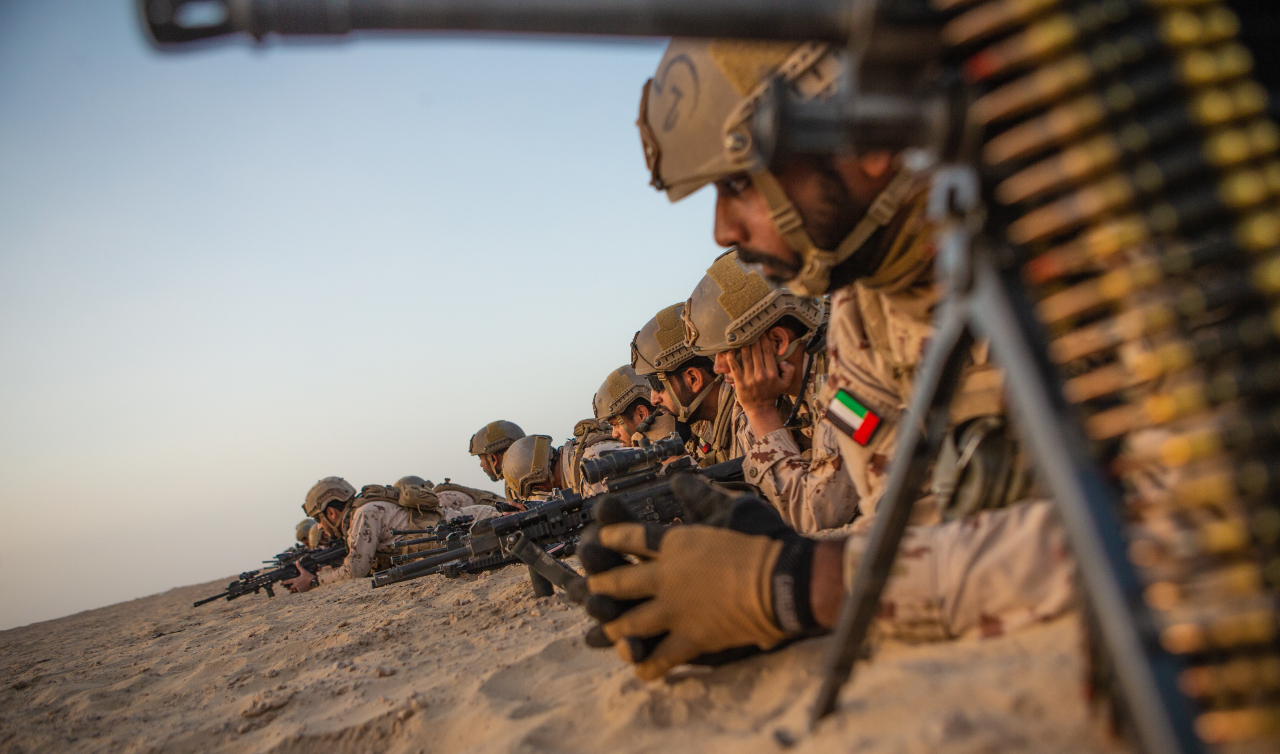The UAE in Yemen: From Surge to Recalibration
The Emirati intervention in Yemen ramped up, then drew down. What were they hoping to accomplish?

Published by The Lawfare Institute
in Cooperation With

Editor’s Note: Despite its small size, the United Arab Emirates has emerged as one of the most important players in the Middle East. It has done so by shrewdly strengthening its alliances with the United States and Saudi Arabia while intervening militarily and financially throughout the region. Thomas Juneau of the University of Ottawa explains the logic of the UAE’s emergence as a major player, with a focus on how the UAE calibrates its strategy in Yemen, one of the region’s hotspots.
Daniel Byman
***
The growing foreign policy assertiveness of the United Arab Emirates (UAE) has attracted much attention in recent years, as witnessed by its deal in August 2020 to normalize relations with Israel. The UAE has also been especially visible in Yemen: It has played a prominent role in the Saudi-led coalition that intervened in 2015 at the request of the internationally recognized government of President Abd-Rabbu Mansour Hadi, which had been expelled from the capital by an Iran-aligned group, the Houthis.
As I argue in a recent article in Survival, the UAE can plausibly claim to have reaped significant benefits from its intervention in Yemen. It established a strong foothold in the south; learned much about projecting power in a war-torn country with which it shares no land border; and, so far, mostly managed its most important bilateral relationships, with Saudi Arabia and the United States. At the same time, the Emirati investment in Yemen has proved costly, which led it to partially withdraw its forces in 2019.
Ramping Up, 2015-2019
The UAE’s key objective in Yemen is to manage its most important foreign policy priority: its often-difficult relations with Saudi Arabia. The Emirati crown prince and de facto ruler, Mohammed bin Zayed, has decided that bandwagoning with its bigger neighbor can act as a force multiplier: It allows the UAE to carve out a space alongside Saudi Arabia to pursue its own objectives.
Managing relations with Washington is the UAE’s other fundamental priority. The Emiratis have achieved greater alignment with the Trump administration, notably on Iran policy, but after early enthusiasm, Emirati leaders have become disillusioned with Trump’s erratic and unreliable policies, in particular his vow to disengage from the Middle East.
The UAE also realized more quickly than Saudi Arabia that, despite steadfast support from the Trump administration, the intervention in Yemen was facing mounting criticism from Congress and the U.S. media. The UAE was keenly aware that this public relations challenge could intensify, even if it has been adroit in deflecting negative press coverage toward Saudi Arabia.
The main threats that the UAE perceives to its security converge in Yemen. First, one of the main drivers of Emirati foreign policy is its opposition to the Muslim Brotherhood. The UAE fears, in particular, the Brotherhood’s alternative blueprint for state power derived from political Islam and the challenge it poses to hereditary monarchies. In Yemen, this has translated into systematic efforts to weaken Islah, roughly the Yemeni branch of the Brotherhood and a key partner of the Hadi government. The UAE is also concerned with the actions of Qatar, which supports Brotherhood-aligned groups throughout the region, including possibly Islah.
The UAE and Saudi Arabia grew increasingly alarmed in 2014 and 2015 as the Houthis expanded their power. Like Saudi Arabia, the UAE views the Houthis as close partners of Iran, but whereas Saudi Arabia inflates Iranian influence over the Houthis, the UAE has a more realistic view that recognizes that the Houthis are not Iranian puppets. Through its opposition to the Houthis, the UAE intends to send the message to Iran that it opposes its influence in Arab affairs, but it has not intervened in Yemen primarily to counter Iran; it is a concern, but not the dominant one.
The UAE also wants to oppose al-Qaeda in the Arabian Peninsula (AQAP) and the (weaker) Islamic State in Yemen (ISY). Countering AQAP is an end in itself, but also a means: The local militias the Emiratis have mobilized to fight AQAP are useful assets to project its influence in southern Yemen. Moreover, the UAE has successfully positioned itself as the United States’s indispensable local partner in counterterrorism operations.
Finally, the UAE’s model of economic development is premised on its position as a logistics hub for regional trade. Maritime security is thus a vital interest, especially in the U-shaped area around the Arabian Peninsula encompassing the Persian Gulf, the Arabian and Oman seas, the Gulf of Aden, and the Red Sea. In Yemen, this has translated to the UAE seeking influence over ports and surrounding areas on the country’s southern and western coasts.
The UAE’s strategy has been premised on its ties to southern actors, especially the Southern Transitional Council, a coalition of separatists. The UAE has also mobilized, trained and equipped southern militias. This is not out of sympathy for their aspirations but, instead, is the product of necessity: Southern groups are opposed to Islah, for historical reasons, making them natural partners. Geography also brings them together, since the UAE seeks a presence on the southern coast.
The UAE also supports Tariq Saleh, a nephew of former president Ali Abdullah Saleh, who leads military units previously loyal to his late uncle. Tariq and other members of the Saleh clan have a poor relationship with Islah; the UAE thus views its support as another tool to undermine the Brotherhood in the country. The UAE, moreover, likely views the Saleh clan as possible leaders in post-war Yemen; to the UAE’s benefit, they would be dependent on Emirati support and would symbolize, as relatives of the dictator of 32 years, the failure of the 2011 uprising.
Recalibrating, 2019 and After
By 2019, the UAE had come to believe that the costs of its involvement in Yemen outweighed the benefits, and that this negative cost-benefit ratio might worsen in the future. It therefore announced in June 2019 a partial withdrawal of its forces from Yemen. It has, however, maintained a presence in the south, focused mostly on counterterrorism, and continues supporting some southern groups.
Those earlier gains were important. The UAE has built major influence in southern Yemen, much of which it has maintained even as it drew down its forces. It has also become skilled at mobilizing, training, and equipping non-state militias and exploiting them to project its power regionally, a valuable asset that Iran largely monopolized in the Gulf until recently. The UAE has also learned a lot by working closely with the United States in mounting counterterrorism operations in Yemen.
Yet despite these real successes, the war in Yemen was proving costly. The Emirati leadership, moreover, understood that the way ahead would likely become increasingly difficult to manage. The war was increasing tensions inside the UAE, a federation where the balance among the seven emirates can be fragile. Combat casualties, in particular, came primarily from the smaller and poorer emirates traditionally dominated by the richer Abu Dhabi and Dubai, while more trade-oriented emirates (especially Dubai) were growing increasingly concerned at the risk of conflict as a result of an assertive foreign policy driven primarily by Abu Dhabi. Heavy UAE involvement in Yemen was also creating uncertainty in Emirati-Saudi relations. Despite successful efforts so far to manage these differences, on the ground Saudi Arabia and the UAE often work at cross-purposes; Saudi- and Emirati-backed groups have even clashed on several occasions. The UAE also saw, with growing anxiety, mounting opposition to the war from the United States. Finally, some of the UAE’s associations in southern Yemen have proved risky and could become costlier in the future. The UAE, in particular, has supported—directly and indirectly—a range of groups and militias, including Salafists with ties to AQAP.
An eventual political process will see these contradictions play out. In a best-case scenario, Riyadh and Abu Dhabi could eventually find common ground in supporting a federal solution, allowing the UAE to consolidate its influence in an autonomous south—though, unfortunately, that scenario remains a long way off. In the meantime, even though the UAE has made efforts to minimize and contain its losses in Yemen, its ongoing commitment remains risky. The situation in the south, in particular, is volatile. The UAE’s involvement in Yemen, in sum, faces a rocky road ahead, as does its most important success: its partnership with Saudi Arabia.





